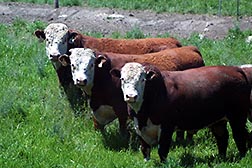| Read the magazine story to find out more. |
|
|
|
|
Analyzing Disease Mutations Using Online Cattle Genomes
March 8, 2017
Thanks to U.S. Department of Agriculture (USDA) scientists, a genomic database of U.S. beef cattle is now available online.
The complete genomes of 96 bulls representing different U.S. cattle breeds were sequenced by researchers at the Agricultural Research Service's (ARS) U.S. Meat Animal Research Center (USMARC) in Clay Center, Nebraska. The breeds include Angus, Brangus and Hereford.
The publicly accessible information helps scientists identify those traits that breeders and ranchers value, according to USMARC microbiologist Michael Heaton. Heaton and his colleagues started building the panel in the 1990s and recently completed the genomic profiles of the bulls.
In a recent study, Heaton used the online data to analyze a gene associated with brisket disease (pulmonary hypertension), which can cause heart failure in cattle. The data helped identify a mutation. The discovery is important because cattle in feed yards are dying from brisket disease. The disease, which results from elevated pulmonary arterial pressure, is caused by a lack of oxygen and was commonly thought to occur in cattle raised at altitudes of 5,000 feet or higher. The study found the disease is also occurring at normal and intermediate altitudes.
A gene analysis normally takes three months and costs about $3,000. With the new online tool, it only takes three hours and is free. In addition to analyzing gene mutations influencing disease, the panel of genomic profiles also helps in the evaluation of genes affecting production traits such as growth and reproduction.
The sequence is accessible at https://www.ars.usda.gov/plains-area/clay-center-ne/marc/wgs/main/.
Read more about this research in the March issue of AgResearch.
For more information contact Sandra Avant, ARS Office of Communications.
The Agricultural Research Service is the U.S. Department of Agriculture's chief scientific in-house research agency. Daily, ARS focuses on solutions to agricultural problems affecting America. Each dollar invested in agricultural research results in $17 of economic impact.

